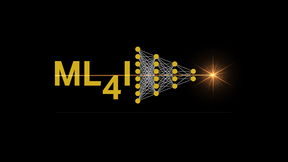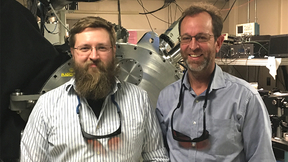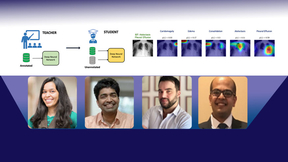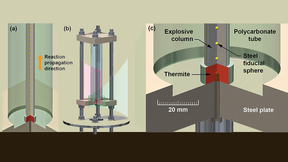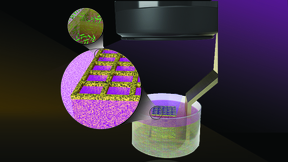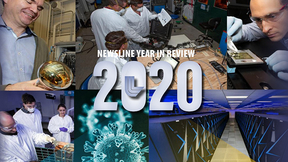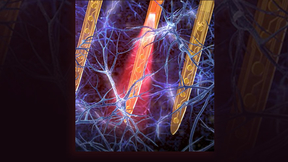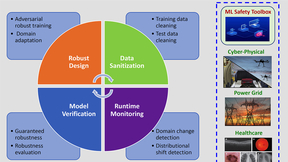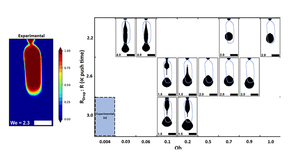Back
Engineering
Conference papers highlight importance of data security to machine learning
The 2021 Conference on Computer Vision and Pattern Recognition, the premier conference of its kind, will feature two papers co-authored by a Lawrence Livermore National Laboratory (LLNL) researcher targeted at improving the understanding of robust machine learning models. Both papers include contributions from LLNL computer scientist Bhavya Kailkhura and examine the…
Students build knowledge of machinist trade during Lab's first-ever virtual Manufacturing Workshop
The COVID-19 pandemic didn’t prevent local high school students from learning what it’s like to be one of the more than 150 machinists who work at Lawrence Livermore National Laboratory (LLNL) during the Materials Engineering Division’s (MED) Manufacturing Workshop, held April 20-22. Students attended the three-day workshop virtually after their school days ended, where…
Lawrence Livermore takes part in international planetary defense conference
Ten scientists from Lawrence Livermore National Laboratory (LLNL) last week took part in the 7th IAA Planetary Defense Conference (PDC), hosted by the United Nations Office for Outer Space Affairs in cooperation with the European Space Agency. Megan Bruck Syal, who helped lead the Lab’s participation in the event and who also was a conference session chair, said this year…
Lab offers forum on machine learning for industry
Lawrence Livermore National Laboratory (LLNL) is looking for participants and attendees from industry, research institutions and academia for the first-ever Machine Learning for Industry Forum (ML4I), a three-day virtual event starting Aug. 10. Pre-registrations are open for the forum, which aims to foster and illustrate the adoption of machine learning methods for…
LLNL researchers and business development executives capture best-ever three technology transfer awards
Researchers from Lawrence Livermore National Laboratory (LLNL) and their colleagues who help them commercialize technologies have won three national technology transfer awards this year. The trio of awards, from the Federal Laboratory Consortium (FLC), represent the most national awards that LLNL has ever won in one year’s competition over the past 36 years. Two of the…
Scientists put additive manufactured foams to the test
Lawrence Livermore National Laboratory (LLNL) scientists recently published the results of a three-week experimental campaign at the Lab’s Jupiter Laser Facility to test the performance of laser-heated additive manufactured foams. The project helps support two major Laboratory focus areas, including helping to advance additive manufacturing and by enabling improvements in…
Scientists put additive manufactured foams to the test
Lawrence Livermore National Laboratory (LLNL) scientists recently published the results of a three-week experimental campaign at the Lab’s Jupiter Laser Facility to test the performance of laser-heated additive manufactured foams. The project helps support two major Laboratory focus areas, including helping to advance additive manufacturing and by enabling improvements in…
'Self-trained' deep learning to improve disease diagnosis
New work by computer scientists at Lawrence Livermore National Laboratory (LLNL) and IBM Research on deep learning models to accurately diagnose diseases from X-ray images with less labeled data won the Best Paper award for Computer-Aided Diagnosis at the SPIE Medical Imaging Conference on Feb. 19. The technique, which includes novel regularization and “self-training”…
Retiring Director Bill Goldstein leaves behind a rich legacy of extraordinary growth, innovation for the Lab
Nearly a year into piloting a major scientific institution through one of the most taxing and disruptive global events in modern history, outgoing Livermore Lab Director Bill Goldstein is ready for a vacation. One of Goldstein’s first orders of business following his retirement on March 1 is returning to the lush slopes, coffee plantations and sandy beaches of Kona, Hawaii…
Research on transition phenomena to aid in improving safety of explosives
On Aug. 4, 2020, a massive explosion rocked Lebanon’s capital of Beirut, sending shockwaves through the city and shattering windows, reducing some buildings to rubble and killing at least 200 people. Officials have since traced the blast to a stockpile of more than 2,500 tons of confiscated ammonium nitrate stored in a port warehouse. While the official investigation is…
Lab researchers explore ‘learn-by-calibration’ approach to deep learning to accurately emulate scientific process
Lawrence Livermore National Laboratory (LLNL) computer scientists have developed a new deep learning approach to designing emulators for scientific processes that is more accurate and efficient than existing methods. In a paper published by Nature Communications, an LLNL team describes a “Learn-by-Calibrating” (LbC) method for creating powerful scientific emulators that…
Lab 3D-prints microbes to enhance biomaterials
Lawrence Livermore National Laboratory (LLNL) scientists have developed a new method for 3D printing living microbes in controlled patterns, expanding the potential for using engineered bacteria to recover rare-earth metals, clean wastewater, detect uranium and more. Through a novel technique that uses light and bacteria-infused resin to produce 3D-patterned microbes, the…
Anup Singh selected as new leader for Lab’s Engineering
Anup Singh has been selected as associate director for Engineering at Lawrence Livermore National Laboratory (LLNL). Director Bill Goldstein announced the selection Feb. 1. Singh will assume leadership of the directorate beginning Feb. 22. His selection follows a nationwide search launched after previous Associate Director Anantha Krishnan retired in October. As the leader…
Kim Budil selected as director of Lawrence Livermore
Kim Budil has been named director of Lawrence Livermore National Laboratory (LLNL). Charlene Zettel, chair of Lawrence Livermore National Security, LLC (LLNS), which manages the Laboratory for the Department of Energy's (DOE) National Nuclear Security Administration (NNSA), made the announcement to Laboratory employees Jan. 28. Budil will begin her new role on March 2…
Lawrence Livermore's '2020 Year in Review'
Though 2020 was dominated by events surrounding the COVID-19 pandemic — whether it was adapting to social distancing and the need to telecommute, safeguarding employees as they returned to conduct mission-essential work or engaging in COVID-related research — Lawrence Livermore National Laboratory (LLNL) managed an exceptional year in all facets of science and technology…
LLNL develops optical capability for thin-film neural implants to look into brain activity
Combining hybrid polymer materials with microfabrication and 3D printing, Lawrence Livermore National Laboratory (LLNL) has developed an ultra-compact, lightweight and minimally invasive optoelectronic neural implant that could be used for long-term studies of brain activity. The new implantable devices are built upon a new platform LLNL researchers are calling POEMS …
Diamonds are not just for jewelry anymore
When it comes to the semiconductor industry, silicon has reigned as king in the electronics field, but it is coming to the end of its physical limits. To more effectively power the electrical grid, locomotives and even electric cars, Lawrence Livermore National Laboratory (LLNL) scientists are turning to diamond as an ultra-wide bandgap semiconductor. Diamond has been…
LLNL physicist wins Young Former Student award
Texas A&M University’s Department of Nuclear Engineering on Dec. 10 announced it has honored Lawrence Livermore National Laboratory (LLNL) physicist Kelli Humbird with its 2020-21 Young Former Student award for her work at LLNL in combining machine learning with inertial confinement fusion (ICF) research. A design physicist at LLNL, Humbird graduated from Texas A&M…
NeurIPS papers aim to improve understanding and robustness of machine learning algorithms
The 34th Conference on Neural Information Processing Systems (NeurIPS) is featuring two papers advancing the reliability of deep learning for mission-critical applications at Lawrence Livermore National Laboratory (LLNL). The most prestigious machine learning conference in the world, NeurIPS began virtually on Dec. 6. The first paper describes a framework for understanding…
Lab study of droplet dynamics advances 3D printing
A team of Lawrence Livermore National Laboratory (LLNL) scientists has simulated the droplet ejection process in an emerging metal 3D printing technique called “Liquid Metal Jetting” (LMJ), a critical aspect to the continued advancement of liquid metal printing technologies. In the paper, the team describes the simulating of metal droplets during LMJ, a novel process in…





